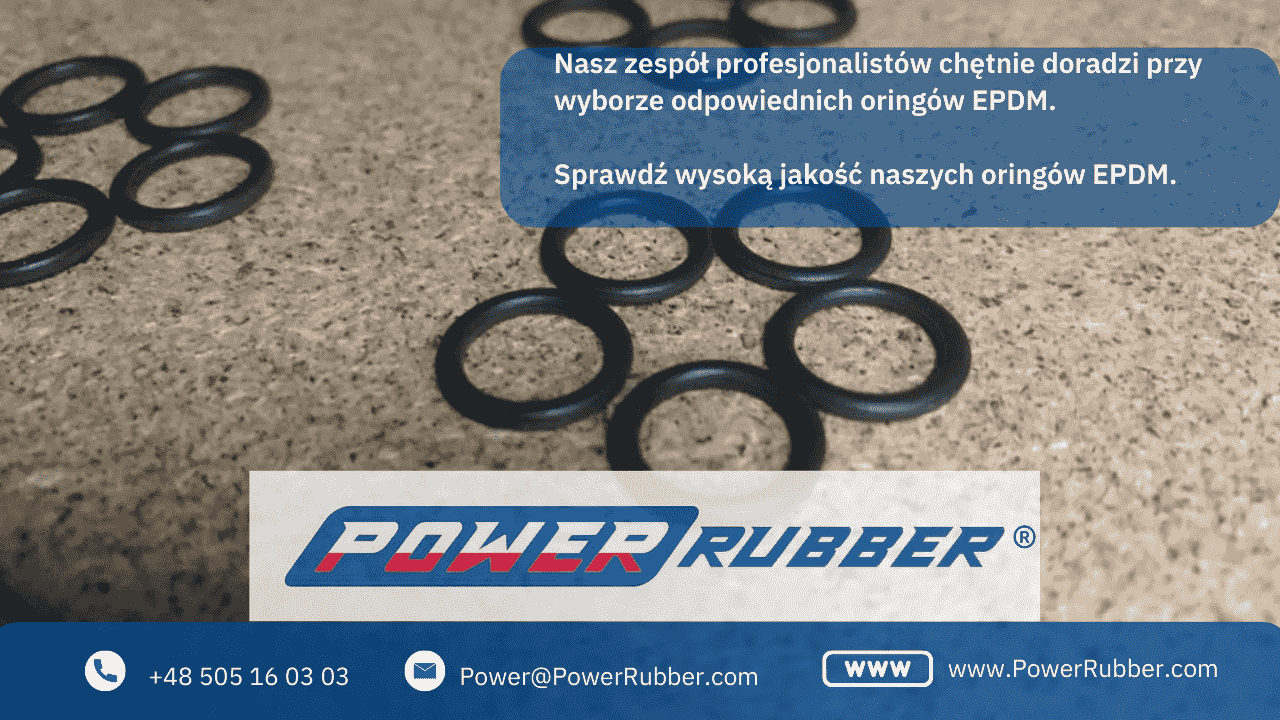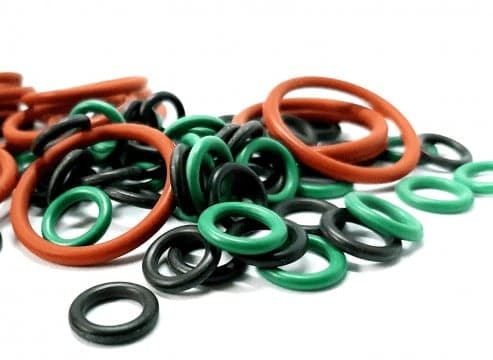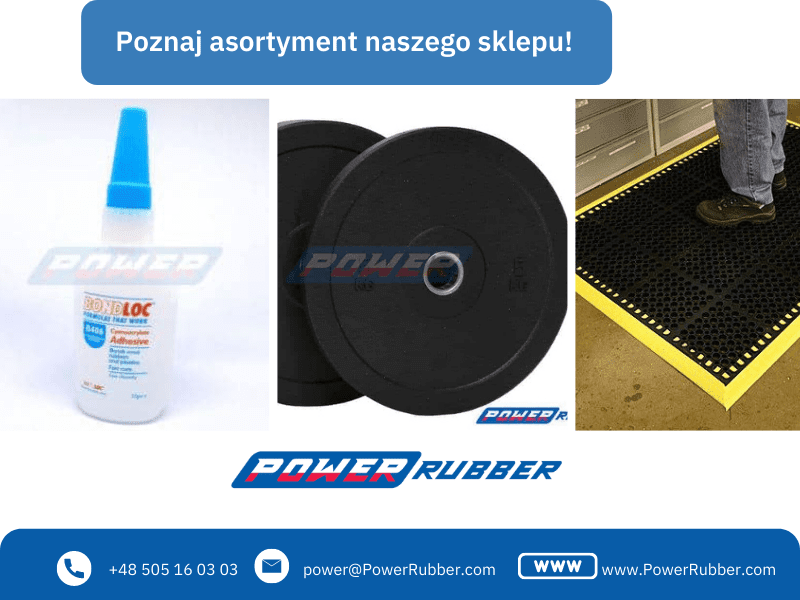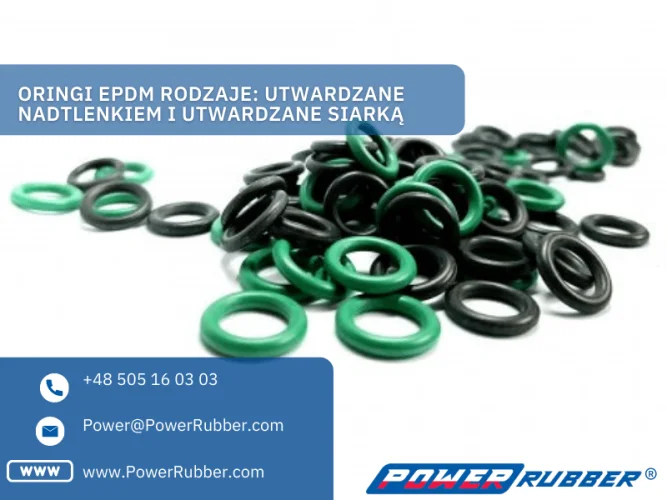EPDM o-rings types: peroxide cured and sulfur cured
EPDM (ethylene propylene diene monomer) is an elastomer with a diverse range of applications that is formed by the sulfur or peroxide vulcanization process. Thanks to its properties (resistance to water, water vapor, ozone, UV radiation, hydraulic fluids) it is used all over the world.
Vulcanization
Vulcanization (curing) is the process by which long polymer chains are formed interconnected to form a highly flexible, homogeneous product. The process of curing the rubber occurs during the application of a sufficiently high temperature for a certain period of time. EPDM rubber is an elastomer that is carbonized by sulphur and peroxide vulcanization. Both ways of vulcanization bring with them some advantages and disadvantages.
EPR – What is it?
EPR is an ethylene-propylene rubber that is a copolymer of ethylene and propylene. EPDM synthetic rubber is an ethylene and propylene terpolymer with a small amount of a third monomer (most commonly diene), which allows sulphur vulcanization. EPDM offers exceptional properties, i.e. resistance to weathering, ozone, chemical resistance (m.in. to diluted acids and aesths, polar solvents), excellent flexibility in low temperature environment, electrical insulation. The wide application of EPDM is useful in many industries.
Types of EPDM orings
We distinguish EPDM orings dotted in the process of sulfur and peroxide vulcanization. The choice of curing method depends on the required properties that are needed for specific applications. Peroxide-cured elastomers are more resistant to high temperatures, while sulphur-cured elastomers have better elasticity. Below we will take a closer look at these two types of EPDM orings. 
Peroxide-cured EPDM orings
EPDM synthetic rubber has exceptional resistance to ozone, weather conditions and high temperatures. O-ring seals are exposed to aggressive chemicals, different temperatures, weather conditions and are subjected to cyclical pressure fluctuations, depending on the environment in which they are installed. EPDM orings are cured with sulphur or peroxide to improve the properties of the plastic in specific applications. Find out what properties EPDM peroxide cured has and in which applications it is most commonly used.
Peroxide curing – Properties
Peroxide cured EPDM can withstand high temperatures up to 150ºC. Epdm synthetic rubber vulcanized with peroxide also has resistance to compression and aging (longer service life), as well as to alcohols, hot water, water vapour (up to 204.4º C), engine coolant, brake fluids, ketones, organic and inorganic acids. Peroxide-cured EPDM orings should not be used in applications that come into contact with petroleum-based fuels, lubricants and oils, phosphate-based hydraulic fluids, aliphatic hydrocarbons and mineral oils. Peroxide-hardened seals are suitable for applications requiring cleanliness and hygiene, i.e. for applications requiring cleanliness and hygiene. drinking water, food, beverages (including dairy products).
Sulphur-cured EPDM orings
Changes in the properties of finished rubber products are possible by mixing different types of rubbers. Sulphur vulcanization positively affects the thermal stability of orings and their resistance to chemicals. Sulphur vulcanization may be accelerated or unhurried. Sulphur vulcanization accelerated depends on m.in. the rubber structure and the type of activators.
Sulphur curing – properties
Sulfur-vulcanized EPDM orings offer very good abrasion and tear resistance. Thanks to their flexible properties, they are extended when high stresses occur, which protects orings from breakage. Sulfur-cured orings can withstand a temperature range of -55 º C to +120 º C. Sulfur-based orings have good weather resistance and good dynamic properties. During the sulphur vulcanisation process, a low-intense odour is produced and the cost of production of the products is significantly lower than that of peroxide curing. The use of sulphur during curing also allows more fillers to be used.
Sulphur or peroxide cured EPDM orings – Differences
Epdm material vulcanized with sulfur is characterized by excellent flexibility compared to EPDM cured peroxide. Unfortunately, it is more prone to hardening. EPDM, which is axite-mounted vulcanization process, offers better thermal stability and chemical resistance and better compression properties. The advantage of peroxide curing is the formation of C-C (carbon-carbon) bonds, which are thermostable, thanks to which it shows higher and more effective thermal resistance. Orings made of peroxide-hardened rubber can withstand temperatures up to 150º C, vulcanized with sulfur – up to 120º C. On the other hand, peroxide-cured orings are more expensive to manufacture. In addition, peroxide-cured rubber products have greater mechanical strength (compressive resistance) than sulphur-vulcanised products. Sulphur vulcanisms, on the other hand, offer greater tensile, tear and abrasion resistance. During high stress, orings are significantly lengthened, which protects them from rupture.  Buy here: High quality EPDM Oringi
Buy here: High quality EPDM Oringi
Summary
| Sulphur vulcanization | Peroxide vulcanization |
| Advantages: | |
|
|
| Disadvantages: | |
|
|
Comparison with other materials
Epdm and NBR rubber orings
Ethylene-propylene-diene-monomer rubber offers the highest radiation resistance among elastomers. EPDM rubber exposed to the environment is degraded. It also shows weak resistance in contact with aliphatic hydrocarbons. Nitrile capuchin (NBR) is a polymer resistant to aliphatic hydrocarbons and has radiation resistance. Orings made from a mixture of EPDM and NBR rubber increase the service life of a rubber product that is resistant to both UV radiation and aliphatic hydrocarbons. NBR orings also offer high resistance to lubricating oils and polar solvents (acids and aces). Thanks to these properties, NBR orings are often used in applications that come into contact with mineral oil-based oils and lubricants. Orings made of ethylene-propylene-diene rubber are definitely a better choice for external use. This elastomer is definitely more resistant to cold than NBR rubber orings.
Orings Viton (FKM/FPM)
Orings made of FKM (Viton) fluorinated rubber, compared to EPDM rubber, are resistant to hot water, steam, acids and aces. Brake fluids also degrade Viton orings (FKM/FPM). These seals, on the other hand, offer resistance in contact with mineral oils, fuel and lubricants. Both EPDM orings and FKM (Viton) orings have comparable resistance to ozone and weather conditions.
Silicone orings (VMQ)
Rings (orings) made of silicone offer very good insulating properties. Silicone orings show resistance to ozone, weather conditions, chemical resistance (diluted salt solutions, vegetable and animal oils and fats). However, they are not mechanically robust. Due to their low strength, silicone orings quickly wear out and are easy to stretch and tear. Silicone reacts badly to overheated water steam, acids and aesths or aromatic hydrocarbons, so orings made of this material should not be applied in places that come into contact with these agents.
Orings HNBR
As a result of hydrogenation of nitrile rubber (NBR), a synthetic HNBR polymer is formed. O-rings made of this type of material have excellent mechanical strength and are wear-resistant. HNBR orings are resistant to m.in. for hydraulic fluids HFA, HFB and HFC, hot water, ozone, weather conditions, diluted acids and aces. HNBR orings are not compatible with chlorinated hydrocarbons, polar solvents (ketones, esters, ethers), strong acids.
Orings FFKM
FFKM is a perfluor rubber, which is a material with the highest resistance to the operating temperature range up to 320°C, as well as offering high resistance in contact with chemicals. Orings made of FFKM are ideal for critical applications (e.g. jet engines). 
